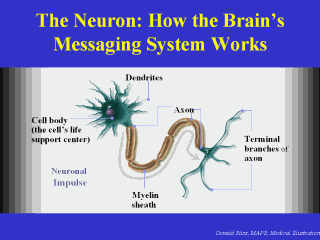 |
Neurons are the brainís messaging system. How
do they communicate with each other? This is a schematic drawing of a
neuron. On the left is the cell body, which contains the cell nucleus.
Extending outward from the cell body are dendrites, which receive
information from other neurons. When the cell body is sufficiently
stimulated, an electric pulse called an action potential is generated that
travels down the axon to the terminal region. It is from the nerve terminal
that brain chemicals (neurotransmitters, such as dopamine) are released into
the synapse or gap between neurons. These chemicals can then attach to
receptors located on the dendrites of neighboring neurons, transmitting
information from one cell to the next. Some axons travel a long distance
(extending all the way from your brain to your toes)--they are covered with
an insulator called myelin, which facilitates the transmission of the action
potential down to the nerve terminal. |
